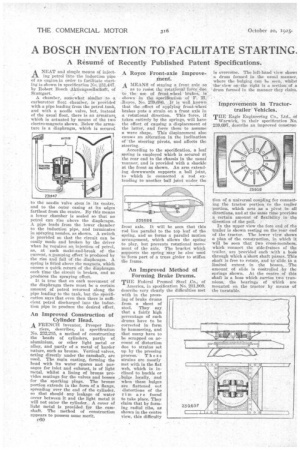A BOSCH INVENTION TO FACILITATE , STARTING.
Page 52

If you've noticed an error in this article please click here to report it so we can fix it.
A Résumé of Recently Published Patent Specifications.
A Royce Front-axle Improve ment. ANEAT and simple means of injecting 'petrol lilt° the induction pipe of an engine in order to facilitate starting is shown in specification No. 231,447. by Robert Bosch Aktiengesellschaft, of
Stuttgart. • .
A chamber, somewhat similar to -a carburetter float., chamber, is provided. with a pipe leading from the petrol.tank, and with a needle valve, but, instead of the usual float, there is an armatureb which i actuated by means of the two electro-magnets shown. Below the armature is a diaphragm, which is secured to the needle valve stem in its centre, and to the outer casing at its edges farthest from the centre. By this means a lower chamber is sealed RO that no petrol can rise above the diaphragm. A pipe leads from the lower chamber to the induction pipe, and terminates in spraying nozzles, as shown. A switch is provided so that the circuit can be easily made and broken by the driver when he requires an injection of petrol, as, at each make-and-break of the current, a pumping effect is produced by the rise and fall of the diaphragm. A spring is fitted above the magnets, which causes a quick return of the diaphragm each timethe circuit is broken, and so
produces the spraying effect. .
It is true that on each movement of the diaphragm there must be a certain amount of petrol returned along the pipe leading to the tank, but the specification says that even then there is sufficient petrol discharged into the induction pipe to produce the desired effect.
An Improved Construction of Cylinder Head. A FRENCH inventor, Prosper Barr
riere, describes, in specification No. 232,215, a method of constructing the • heads of cylinders, partly of aluminium, or other light metal or alloy, and partly of a metal of harder nature, such as bronze. Vertical valves, acting directly under the camshaft, are used. The main casting, forming the head with its water spaces and passages for inlet and exhaust, is of light metal, whilst a lining of bronze provides seatings for the valves and bosses for the sparking plugs. The bronze portion extends in the form of a flange, spreading over the end of the cylinder, so that should any leakage of water occur between it and the light metal it will not enter the cylinder. A cover of light metal is provided for the camshaft. The method of construction appears to possess some merit.
C,60
A MEANS of staying a front axle so . as to resist the rotatiotial"force..due the use of front wheel • brakes, is shown in the. Specification of F. "H. :Royce. No. 239,686. It is well known. that the effect of applying front-Wheel brakes puts a strain on a front axle in a -rotational direction. This force, if taken entirely by the springs, will have the effect of causing a displacement of the latter, and force them to assume a wave shape. This displacement also causes an alteration in the inclination of 'the steering pivots, and affects the steering.
According to the specification, a leaf spring is employed which is secured at the rear end to the chassis in the usual manner, and is provided with a shackle at the front as shown. An arm extending downwards supperts a ball joint, to which is connected a rod extending to another ball joint under the front axle. It will be seen that this rod lies parallel to the top leaf of the spring, and so farms a parallel motion arrangement, which allows the spring to play, but prevents rotational movement of the axle. The bracket which aupports the spring may be also used to 'form part of a truss girder to stiffen the frame.
An Improved Method of Forming Brake Drums.
THE Federal Pressed Steel _Co., of America, in speeification No. 231,909, describe very clearly the difficulties met with in the press ing of brake drums from a sheet of steel. They say that a fairly high percentage of such drums have to be corrected in form by hammering, and that many have to be scrapped on account of distortion due to strains set up by the pressing process. Th ese strains are mostly met with in the flat web, which is inclined to buckle or . bulge locally, and when these bulges are flattened out distortions of the rim are found to take place. They claim that by forming radial ribs, as shown in the centre view, this difficulty is overcome. The left-hand view shows a drum formed in the usual manner, where the bulging can be seen, whilst th& view on•the right is a section' of a drum formed in the manner they claim.
Improvements in Tractortrailer • Vehicles.
THE Eagle Engineering Co., Ltd., of Warwick, in their specification No. 239,697, describe an improved Construe tion of a universal coupling for connecting the tractor portion to the trailer portion, which acts as a pivot inall directions, and at the same time provides a certain amount of flexibility in the direction of the pull. •
In the upper view the fore end of the trailer is shown resting on the •'rear end of the tractor. The lower view shows a plan of the construction, in which it will be seen that two crosS-members, which connect the side-frames of the trailer, are provided each with a bars through which a short shaft passes. This shaft is free to rotate, and to slide to a limited extent in the bosses. The amount of slide is controlled by the springs shown. At the centre of this shaft is a boss which carries two trunnions, the bearings of which are mouutefi on the tractor by means of the turntable. •




















































